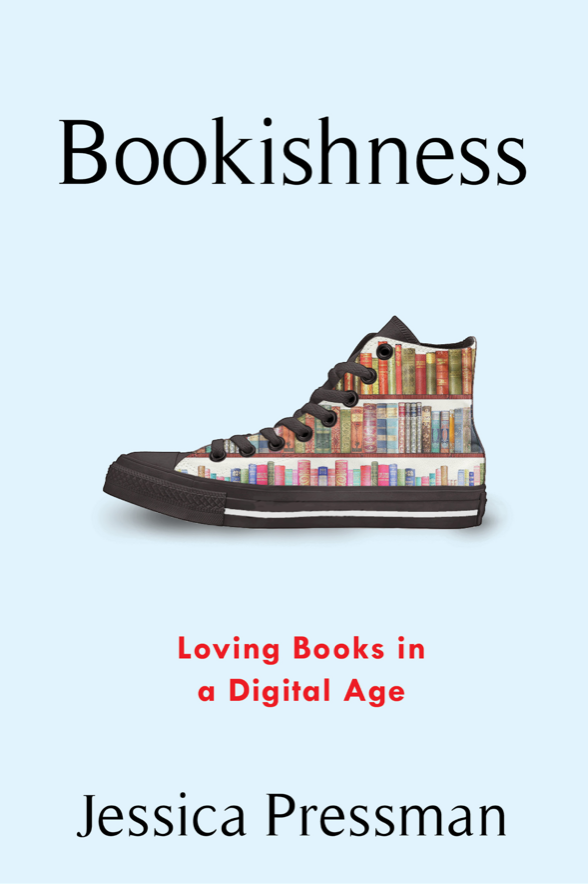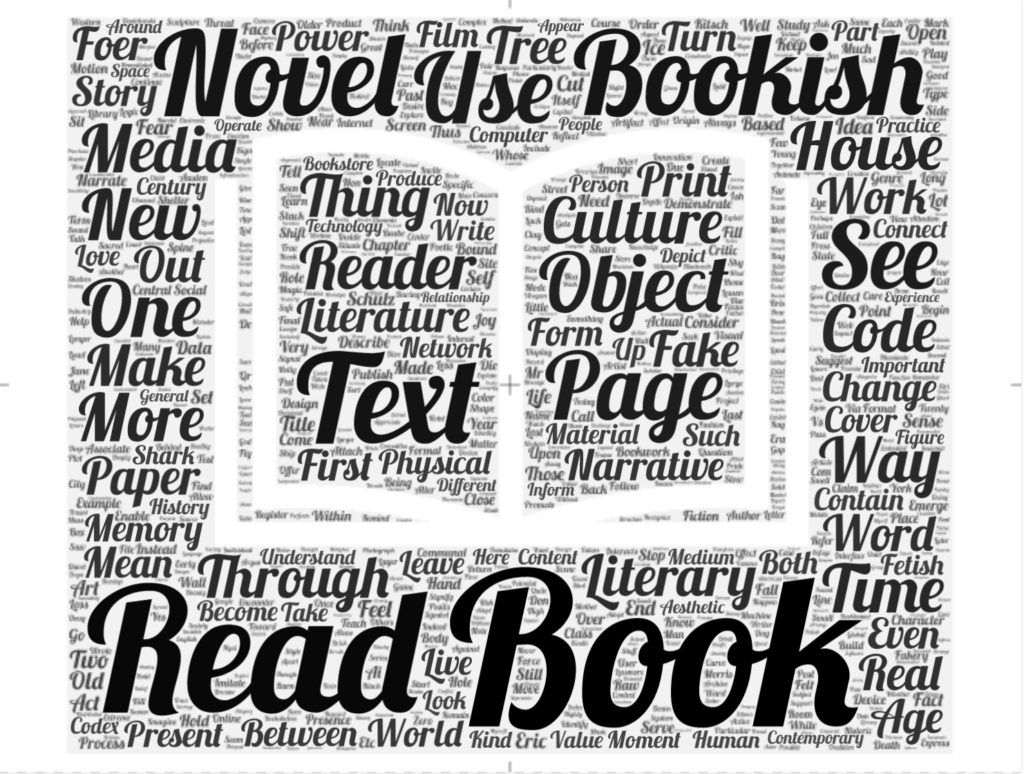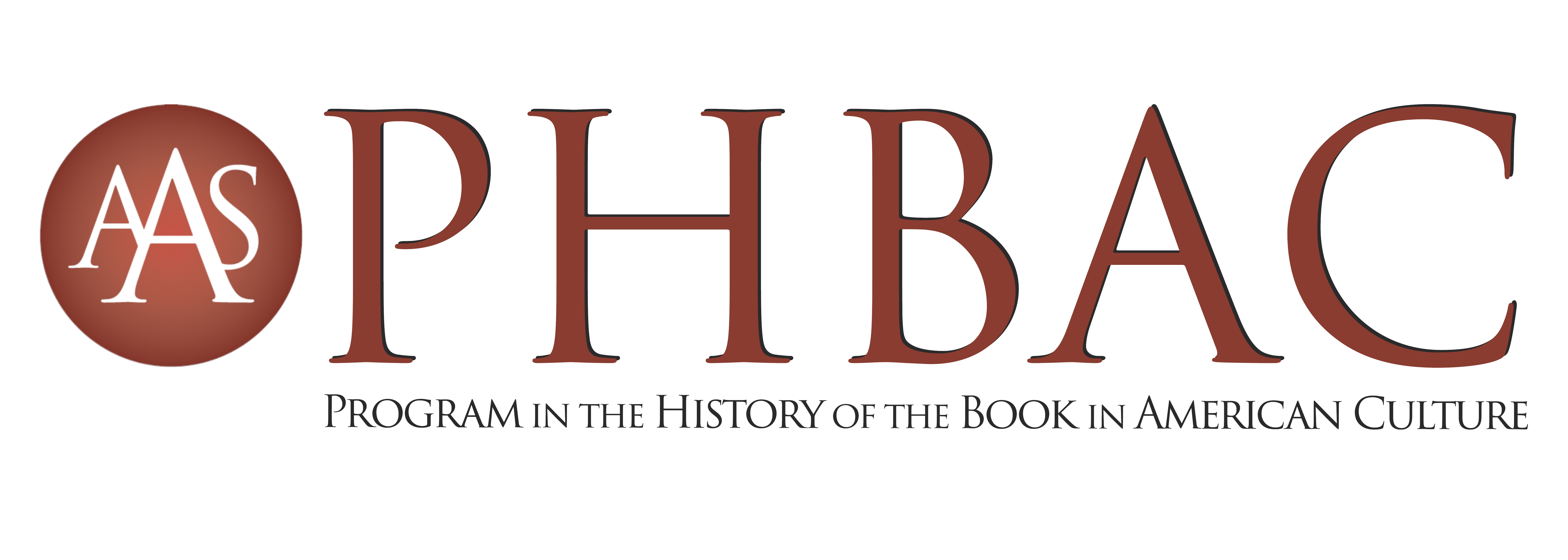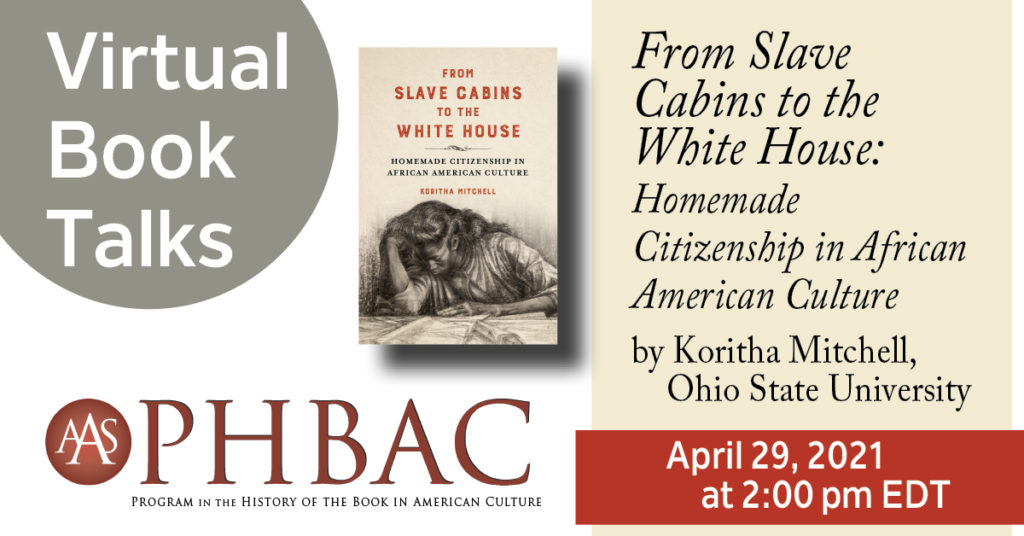Last September, Jessica Pressman, Associate Professor of English and Comparative Literature at San Diego State University, was a featured guest at the Virtual Book Talk series sponsored by the Program in the History of the Book in American Culture (PHBAC). Jessica spoke about her recent publication, Bookishness: Loving Books in a Digital Age, published in December 2020 by Columbia University Press.
The Virtual Book Talk showcases authors of recently published scholarly monographs, digital-equivalents, and creative works broadly related to book history and print culture. Each installment includes an informal presentation from the author and a Q&A with the audience. These talks are streamed live for registered participants and are recorded for posterity. Talks typically last about one hour.
 Jessica’s talk was well attended, and the Q&A that followed the presentation was a lively one. In the limited time that follows a presentation, our guests try to respond to as many questions as possible. Unfortunately, not all questions make it into these programs.
Jessica’s talk was well attended, and the Q&A that followed the presentation was a lively one. In the limited time that follows a presentation, our guests try to respond to as many questions as possible. Unfortunately, not all questions make it into these programs.
Luckily, these questions are recorded, and Jessica has been gracious enough to continue the conversation started at her talk by answering a few of the remaining questions for this article.
For those interested in learning more about Bookishness, please visit the Columbia University Press website.
Q: Is it possible to bring concept of bookishnesss to other contexts, e.g. to book exhibitions?
A: Absolutely. When I say, “bookishness is everywhere,” I mean it. I think book exhibitions—whether displayed on the bookshelves of one’s home or in shelfies distributed on social media, whether curated for libraries and exhibition halls or for decorating a bourgeoisie restaurant—all share a common sense of the book as a tangible symbol of taste and a physical thing of value, but also one whose exhibition matters acutely in our digital moment. Of course, there have been exhibitions of books before computers and digitized culture, but the omnipresence of bookishness—the shared need to express this affiliation and attachment to books—is clearly distinctive and not contained to a specific cultural or disciplinary context. This is what makes it so interesting.
 Q: How would you situate the artist book in your study of bookishness and the development of bookishness?
Q: How would you situate the artist book in your study of bookishness and the development of bookishness?
A: I did a lot of research and thinking about this question. My interest in and exploration of bookwork (that genre of book-based sculpture that I showed in my slideshow, represented by the artists Doug Beube and Brian Dettmer) led me to research artist books and visit university special collections devoted to them (Yale and UCSD, in particular). But it was my personal connection to bookwork artists that taught me to see a distinctive difference between artist books and bookwork.
I would like to answer your question by quoting from an interview I conducted with the Doug Beube and Brian Dettmer: “Bookwork and Bookishness: An interview with Doug Beube and Brian Dettmer” by Jessica Pressman in Book Presence in a Digital Age, eds. Kiene Brillenburg Wurth, Kári Driscoll, and Jessica Pressman (Bloomsbury, 2018):
Jessica: Your work is often seen in relation to artist books, both in connection to and in opposition to that book-based genre of art. Would you say that this reflective, even reflexive, media studies aspect of your work is what serves to distinguish bookwork from artist books?
Doug: I don’t like the term “book artist.” I consider myself a mixed media artist.
Brian: I see our work as being very different from the tradition of artist books. Artist books use the book as a canvas and the work exists and operates within the context of a book. They usually don’t push the structure of the book medium or question the context of the book itself. In my art I ask “How is this [the book] an interesting media to use and to comment upon?” I am more interested in the book as a found object or cultural artifact to explore. Take an analogy to Nam June Paik’s sculptures employing television and video. He did not write TV shows within the medium but rather used the medium, the hardware of the TV, to create sculpture about the medium. A farmer who grows trees is in a different field than a sculptor who makes wooden carvings. When put in the same genre as book makers I like to joke that I don’t do book-making; I do book-breaking.
Doug: An important distinction between bookwork and artists’ books is that artists’ books still function as books; you open them and interact with them by flipping pages, there are exceptions but for the most part they function like a book. In contrast, in my work, I challenge the way we interact with and think of these objects. My work is not about binding but about context and how the book sits in space.
I think this selection from our conversation suggests a need to think carefully and in nuanced ways about art made from books and books made as art. I offer “bookishness” as a conceptual category, an umbrella term of sorts, for exploring what these various genres share— a love of books— but also one that leaves room for understanding their distinctions.
Q: Especially in the book as memorial, bookishness seems reactive to perceived threats or competitors to the book as a medium. Are there examples of bookishness as proactive and expansive rather than as opposed to protective of the past?
A: I don’t think memorials have to adhere to an either/or binary of reactive or proactive, backwards or forward-facing. Bookishness certainly shows how bookish memorials do both simultaneously. My chapter titled “Memorial” takes Jonathan Safran Foer’s Tree of Books (2012) as its case study, and Foer’s book is very “proactive and expansive.” It is a formal experiment in die-cutting and in the poetics of erasure, for Foer cuts his text from Polish author Bruno Schulz’s The Street of Crocodiles (1934). The book is, I argue, a memorial to Schulz and the Holocaust but also to books in a digital age. Yet, Foer’s book is also a provocatively beautiful example of a digitally-enabled and, thus, potentially mass-produced “artist” book. It is a heartbreakingly beautiful bookish memorial that proactively provides groundwork for new experimentations. Foer’s work is not alone in demonstrating how bookishness creates book-based literature for a digital moment. Bookishness provides many examples of cultural objects that use books or book imagery to reference a past and establish a bookish future.
Here I think it might be helpful to recall J. Paul Hunter’s great scholarly book on the history of the novel, Before Novels: The Cultural Context of Eighteenth Century English Fiction (New York: WW Norton, 1990). Hunter argues that the novel genre emerges from popular culture and media, from engagement with periodicals and personal narratives, not as a means of reactive retreat and retrenchment but for inspiration and source material. Early novels incorporated popular culture in ways that produced new literature, enabling the novel to continually renovate and remain new (novel).
Making it new, from Ezra Pound onwards, means turning to the past for inspiration and, often, source material, in order to make new art. Making it new also means a memorializing the past in the new. My first book explored this very topic. Digital Modernism: Making it New in New Media (Oxford University Press, 2013) argues that creators of born-digital literature mine modernist literature for inspiration in strategic ways: to situate their new literature within a canonical tradition that is taken very seriously. It is interesting to see myself returning to this train of thought in relation to the new book. I had not recognized this connection until your question prompted my consideration. Thank you for the prompt!
Our next book talk takes place on April 29 and features Koritha Mitchell, author of From Slave Cabins to the White House: Homemade Citizenship in African American Culture. Registration is open here.
Questions or comments related to the program may be directed to Kevin Wisniewski, Director of Book History and Digital Initiatives, at kwisniewski@mwa.org.


